Back to Lecture
23
BACK TO DINOSAURS 2001 HOME PAGE
Lecture 24 - The Impact Theory of Mass Extinction
In previous lectures we looked at the range of dinosaurs that existed at
the close of the Cretaceous. We can now turn our attention to the events
around the great mass extinction event that involved the elimination of
the non-avian dinosaurs as well as the associated extinctions.
I. GENERAL PATTERN OF EXTINCTIONS
Recall that in the 18th century Georges Cuvier worked on the stratal successions
around
Paris and believed that the history of life was marked by periods of
creation, stasis, then obliteration. This catastrophic view of the history
of life was countered by Charles Lyell's extreme uniformitarian view that
very small changes added up over vast amounts of time were responsible
for the seemingly great changes seen in the geological record. Lyell actually
believed, at least early on, that there were no extinctions, just changes
in abundances.
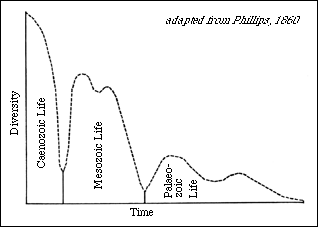 However, by the mid 19th century
the basic shape of diversity of life was fairly well understood, and there
did seem to be an overall pattern. In 1860, paleontologist John Phillips
formalized what was known about diversity from the Cambrian Period on by
recognizing (left) the Paleozoic Era (or ancient life), the Mesozoic Era
(or middle life), and the Cenozoic Era (or recent life), with each era
boundary marked by a period of lowered diversity - in other words by a
period of accelerated extinction. The most abrupt of these reductions in
diversity was the boundary between the Mesozoic and Cenozoic - that is
between the Cretaceous and Tertiary Periods.
However, by the mid 19th century
the basic shape of diversity of life was fairly well understood, and there
did seem to be an overall pattern. In 1860, paleontologist John Phillips
formalized what was known about diversity from the Cambrian Period on by
recognizing (left) the Paleozoic Era (or ancient life), the Mesozoic Era
(or middle life), and the Cenozoic Era (or recent life), with each era
boundary marked by a period of lowered diversity - in other words by a
period of accelerated extinction. The most abrupt of these reductions in
diversity was the boundary between the Mesozoic and Cenozoic - that is
between the Cretaceous and Tertiary Periods.
Darwin, who applied Lyellian Uniformitarianism to biology, thought
the fossil record was a bit of an embarrassment to his theory of evolution,
especially in the apparent lack of intermediates. Darwin felt that the
lack of intermediates was due to the imperfection of the geological record,
and that they must be there - and of course intermediates between major
groups, like Archaeopteryx, were soon discovered.
The dual successes of Lyellian Uniformitarianism and Darwinian
evolution lead to a view that persisted for the next century - that interpretations
of the geological record in terms of discontinuities or catastrophes was
to be more-or-less abhorred - and indeed there was precious little real
evidence that this approach was not justified.
However, by the 1960's and 1970's paleontologists began to carefully
compile literature records of taxa from strata of different ages. It became
apparent that there really were times of very high extinction rate.
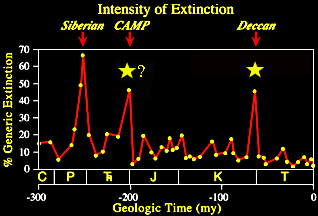 A
more recent tabulation (right) of shelly marine invertebrates by Jack Sepkoski
of the University of Chicago shows that there have been several times in
the last 270 million years (the better-preserved part of the record) when
there were very high levels of extinction. In this graph, "percent extinction"
is the number of extinctions of genera in an interval of time divided by
the number genera present (or at risk) in that interval, times 100 (to
make it a percent). Note the large peaks in extinction at the end of the
Permian, Triassic, and Cretaceous periods.
A
more recent tabulation (right) of shelly marine invertebrates by Jack Sepkoski
of the University of Chicago shows that there have been several times in
the last 270 million years (the better-preserved part of the record) when
there were very high levels of extinction. In this graph, "percent extinction"
is the number of extinctions of genera in an interval of time divided by
the number genera present (or at risk) in that interval, times 100 (to
make it a percent). Note the large peaks in extinction at the end of the
Permian, Triassic, and Cretaceous periods.
Particularly the Cretaceous-Tertiary (K-T) boundary stands out
because there was considerable stratigraphic evidence that marine and continental
extinctions looked like they might be synchronous. In specific the marine
biota was hit very hard:
15% of all marine families (Sepkoski, 1982)
but 50 % at generic level
and maybe 80-90 % of all species.
The continental biota was also hit hard:
about 25 % at the family-level became extinct
but about 56 % at the genus
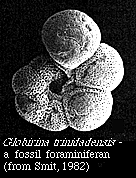 Let look
now at some specifics, sort of a body count:
Let look
now at some specifics, sort of a body count:
MARINE ORGANISMS (particularly important ones in bold)
planktonic foraminifera 83%
ostracodes -50 %
sponges -69 %
corals -65 %
sea urchins -54%
ammonites -100%
marine reptiles 93 %
CONTINENTAL ORGANISMS
reptiles in general -56%
but non-avian dinosaurs and pterosaurs -100%
But many things also made it through or were relatively unaffected:
higher plants -10 %
dinoflagellates -5 %
mammals +120 %
ON LAND NOTHING BIGGER THAN 25 KG SURVIVED
ALL SURVIVORS WERE SMALL - LIZARDS, SNAKES, CROCODILES, TURTLES,
MAMMALS, FROGS, SALAMANDERS
These extinctions were clearly of great magnitude, but in the intellectual
milieu of the time, there was much speculation, but little specific work
on the nature of the K-T boundary.
Explanations included:
Evolutionary Senility
Could not eat the evolving flowing plants
It got too cold
It got too hot
Mammals ate all of the eggs
They all died from a disease
They all became female when the climate changed
The sea level changed too fast
There was massive volcanism covering everything with ash
There was a nearby supernova of a star
Earth was hit by an asteroid
II. THE ASTEROID IMPACT THEORY BECOMES TESTABLE
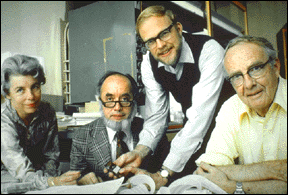 All this changed in 1980 when Nobel laureate Luis Alvarez, his geologist
son Walter Alvarez, nuclear chemist Frank Asaro, and paleontologist Helen
Michael (on left, from right to left), published on their discovery of
high levels of the element Iridium in a clay layer separating marine sediments
of Cretaceous and Tertiary age.
All this changed in 1980 when Nobel laureate Luis Alvarez, his geologist
son Walter Alvarez, nuclear chemist Frank Asaro, and paleontologist Helen
Michael (on left, from right to left), published on their discovery of
high levels of the element Iridium in a clay layer separating marine sediments
of Cretaceous and Tertiary age.
Originally, Water Alvarez, a geologist at Berkeley, was looking for
some way to quantify the rates of faunal change around the K-T boundary.
To do this he needed a timekeeper. He and his father reasoned that the
rain of dust from outer space should be coming down, on average, at a constant
rate. Let's say it came down at a rate of 0.0001 g/yr on 1 cm2 of the ocean
floor. It would be diluted by clay and microfossils also from the ocean
to make sediment. So, if you had a 10 g sample of Cretaceous oceanic sediment
with 1 g of space dust in it, it would have been deposited in 10,000 years
[1 g / (0.0001 g/yr = 10,000 yr]. All you had to do was find a way of measuring
space dust. It turns out that is not as hard as you might think.
Remember, back in Lecture 10 that during
the iron catastrophe most of the compliment of heavy elements that the
Earth received during its accretion sank to its core. Iron was the main
element, but along with it went most of the platinum and related elements
called the platinum group. That way Platinum is a rare and expensive mineral
on the Earth surface. Platinum group elements are thus much more common
in your average space dust, than on the crust. These Platinum group elements
would thus be a good signature for space dust in sediments. Better yet,
Platinum group elements don't move around much once they are deposited.
They are some of the so-called noble metals that tend to be unreactive
and virtually inert. Of the Platinum group elements, Iridium (Ir) was relatively
easy to measure, detectable in parts per billion. Thus Ir proved to be
the element of choice to measure as a proxy for space dust.
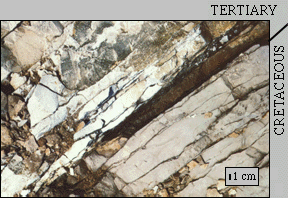 The
next thing to do was to find an outcrop of rock deposited in the deep ocean
where the K-T boundary was well exposed and paleontologists were sure it
was properly identified. Their choice turned out to be a highway cut in
Gubbio, Umbria, Italy (on right). The boundary was clearly marked out by
the disappearance of many kinds of Cretaceous microfossils, particularly
most foraminiferans. At the boundary is a thin layer of brown and black
clay. So the Alvarez group sampled carefully through this rock section
and analyzed for Ir (below).
The
next thing to do was to find an outcrop of rock deposited in the deep ocean
where the K-T boundary was well exposed and paleontologists were sure it
was properly identified. Their choice turned out to be a highway cut in
Gubbio, Umbria, Italy (on right). The boundary was clearly marked out by
the disappearance of many kinds of Cretaceous microfossils, particularly
most foraminiferans. At the boundary is a thin layer of brown and black
clay. So the Alvarez group sampled carefully through this rock section
and analyzed for Ir (below).

(adapted from Alvarez, et al., 1980)
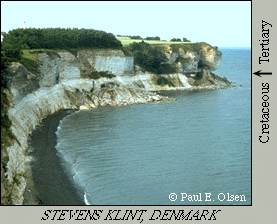 They were
astonished to find that there was very little change in Ir content through
the section, except in the clay layer. They did their calculations only
on the basis of leaching out all of the calcium carbonate from the samples,
so they would only be measuring clay. Ir was up by more than an order of
magnitude (factor of ten) in the clay bed, exactly where the extinctions
occurred. They checked at two other sites, one in New Zealand and one at
Stevns Klint in Denmark (right). What could have caused this? Two hypotheses
were possible.
They were
astonished to find that there was very little change in Ir content through
the section, except in the clay layer. They did their calculations only
on the basis of leaching out all of the calcium carbonate from the samples,
so they would only be measuring clay. Ir was up by more than an order of
magnitude (factor of ten) in the clay bed, exactly where the extinctions
occurred. They checked at two other sites, one in New Zealand and one at
Stevns Klint in Denmark (right). What could have caused this? Two hypotheses
were possible.
1) something shut off the production of clay, while the rain of Ir in
space dust remained constant.
2) something boosted the amount of space dust (and hence Ir) by
and order of magnitude.
They could not find a reason that it should be #1, so they opted
for #2. But why should space dust go up? There could be two easy hypotheses
to do this:
1) a nearby star could have gone supernova, showering the Earth
with newly formed elements heavier than iron - among them Ir.
2) the Ir could have come from a mass of extraterrestrial matter
arriving in one chunk - as a giant meteor or comet.
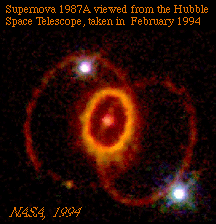 |
The key in science is not postulating causes, but rather testing hypotheses.
So they reasoned that if it was # 1, one of the other elements that should
have been created would be Plutonium (Pu), specifically Pu244,
a radioactive isotope ("bomb" Plutonium). Pu244 was created
during the supernova that led to our solar system (see Lecture
10), but nearly all has decayed to lead by now. However, if the Ir
in the K-T boundary layer had come from a supernova 65 million years ago,
there would be quite measurable amounts left. So they looked. The result
was no measurable levels of Pu244. Their argument against a
supernova was bomb proof (pun intended). However, it was a definite possibility.
Click
here to see links to a recent supernova.
Thus, they argued that this Ir-enriched layer was caused by the impact
of a giant asteroid (~10 km) that put enough dust into the upper atmosphere
to darken and hence cool the Earth for several years. This was theorized
to result in shutting off global photosynthesis, with the resulting collapse
of the global food chain. As a result nothing larger than 25 kg survived
the boundary. This concept was promptly co-opted as a plausible scenario
for the events following a nuclear holocaust (Nuclear Winter) as well. |
III. IMPACT THEORY CORRABORATED
There were two big holes in the theory, however. One was that Ir enrichment
could have occurred by volcanic eruptions as indicated elevated Ir levels
in vapors from Kilauea Volcano in Hawaii. The other was that there was
no impact site known.
A key observation was made by Bohor and Izett in 1986 when they discoed
shocked quartz at Cretaceous-Tertiary boundary sections in the western
US. Shocked quartz has only been observed in three settings:
1. High-pressure laboratory experiments.
2. Nuclear test sites.
3. Known giant meteor or asteroid impact sites.
Shocked quartz has never been found in any material from a volcanic eruption.
This discovery, duplicated at may Cretaceous-Tertiary boundary sites, convinced
many scientists that an impact was the only reasonable explanation of the
boundary layer.
Oddly, in 1981, a year after the Alvarez et al. paper came out in Science,
Glen Penfield and Antonio Camargo, petroleum geologists described what
they interpreted to be a giant impact crater about the right age for the
K-T boundary on the north shore of Yucatan in Mexico. Although they did
publish their work, evidently they did not do it in a "flashy" enough journal,
because their work was basically ignored until "rediscovered" by Alan Hildebrand
and William Boynton in 1990. They were led search the literature for evidence
in the Gulf of Mexico area by their discovery of thick layers of impact
debris in Haiti and eastern Mexico that seemed to indicate that the impact
site must have been quite near.
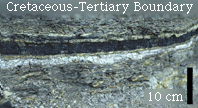 |
Cretaceous-Tertiary boundary section in Raton Basin,
New Mexico (left); shocked quartz (right). |
 |
IV. IMPACT SITE FOUND!
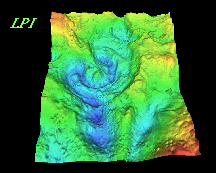
Chicxulub crater, Yucatan Peninsula. |
The impact structure, discovered buried beneath the shore of the Yucatan
Peninsula (Chicxulub = "Mayan devil's tail"), turns out to be from 150
- 300 km in diameter, possibly the largest impact known in the world and
said by some to be the largest known in the solar system. At the present
diverse lines of evidence have largely confirmed the asteroid impact theory
of mass extinctions and identified Chicxulub as the "smoking gun". Debate
still rages by paleontologists about whether the impact was directly the
cause of the extinction itself, or merely the coup de grace. |
V. POSSIBLE KILLING MECHANISMS
In the original Alvarez et. al. model, a 10 km bolide would have struck
the earth sending a large amount of dust into the atmosphere. This would
have blocked sunlight for a some period of time, resulting in massive cooling,
globally, and a collapse of the food chain via. a cessation of photosynthesis.
Since that time (1980) it has been realized that an oceanic impact,
like that at Chicxulub could have much, dire effects.
In specific, the Chicxulub bolide struck a thick deposit of
marine limestone (CaCO3) and underlying marine calcium sulphate (CaSO4
= Gypsum). This probably put large amounts of CO2 and sulfuric acid into
the atmosphere within minutes. The CO2 would have produced an enhansed
greenhouse effect, but the sulfuric acid would result in global cooling.
First, we will look at the greenhouse effect.
| In 1989 O'Keefe and Aherns estimated that the impact of a 12 km diameter
comet or a 14 km asteroid would have raised the average temperature of
the Earth by over 10É (right). This massive heating effect would have lasted
for hundreds to thousands of years, probably making the interior of continents
virtually inhospitable. Eventially the CO2 would be absorbed by the oceans,
plants and the wweathering process. |
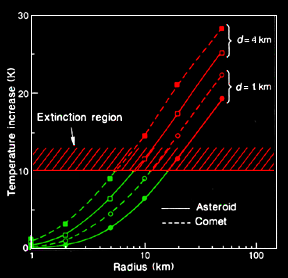
Possible impact-generated CO2 effect on the atmosphere. |
VI. SOME OTHER FACTORS
While there is now a general concensus amoung the geological and paleontological
community that a giant impact did occur, there is still debate about its
effect on the Earth's biota.
This debate breaks down into two catagories.
1. Is the pattern of extinctions actually compatible with an
impact.
2. Were there other things going on that might have contributed
to the extinctions, or even been more important. First we
will look at the biological pattern.
Signor-Lipps Effect
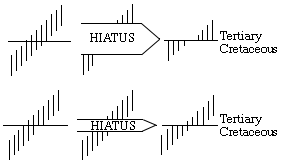
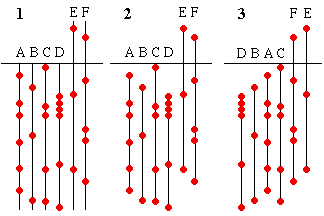
Deccan Volcanism
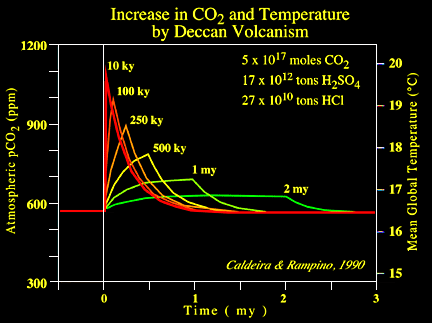
Possible CO2 effect on the atmosphere from Deccan Lavas. From
Caldeira and Ramino (1990).
Note: A very nice chronology of the K-T boundaryu discoveries is given
at:http://www.planetary.org/news/Italy/theory.html
References
Caldeira, K. G. and Ramino, M. R., 1990, Deccan volcanism, greenhouse warming,
and the Cretaceous/Tertiary boundary. Geological Society of America, Special
Paper 247, p. 117-123.
O'Keefe, J. D., and Aherns, T. J., 1989, Impact production of
CO2 by the bolide and the resultant heating of the Earth. Nature, v. 338,
p. 247-249.
Go to Lecture 25, The Cenozoic, the Evolution
of Humans, and our Present Condition
BACK
TO SYLLABUS
BACK
TO THE DINOSAUR AND THE HISTORY OF LIFE HOME PAGE
 However, by the mid 19th century
the basic shape of diversity of life was fairly well understood, and there
did seem to be an overall pattern. In 1860, paleontologist John Phillips
formalized what was known about diversity from the Cambrian Period on by
recognizing (left) the Paleozoic Era (or ancient life), the Mesozoic Era
(or middle life), and the Cenozoic Era (or recent life), with each era
boundary marked by a period of lowered diversity - in other words by a
period of accelerated extinction. The most abrupt of these reductions in
diversity was the boundary between the Mesozoic and Cenozoic - that is
between the Cretaceous and Tertiary Periods.
However, by the mid 19th century
the basic shape of diversity of life was fairly well understood, and there
did seem to be an overall pattern. In 1860, paleontologist John Phillips
formalized what was known about diversity from the Cambrian Period on by
recognizing (left) the Paleozoic Era (or ancient life), the Mesozoic Era
(or middle life), and the Cenozoic Era (or recent life), with each era
boundary marked by a period of lowered diversity - in other words by a
period of accelerated extinction. The most abrupt of these reductions in
diversity was the boundary between the Mesozoic and Cenozoic - that is
between the Cretaceous and Tertiary Periods.
 A
more recent tabulation (right) of shelly marine invertebrates by Jack Sepkoski
of the University of Chicago shows that there have been several times in
the last 270 million years (the better-preserved part of the record) when
there were very high levels of extinction. In this graph, "percent extinction"
is the number of extinctions of genera in an interval of time divided by
the number genera present (or at risk) in that interval, times 100 (to
make it a percent). Note the large peaks in extinction at the end of the
Permian, Triassic, and Cretaceous periods.
A
more recent tabulation (right) of shelly marine invertebrates by Jack Sepkoski
of the University of Chicago shows that there have been several times in
the last 270 million years (the better-preserved part of the record) when
there were very high levels of extinction. In this graph, "percent extinction"
is the number of extinctions of genera in an interval of time divided by
the number genera present (or at risk) in that interval, times 100 (to
make it a percent). Note the large peaks in extinction at the end of the
Permian, Triassic, and Cretaceous periods.
 Let look
now at some specifics, sort of a body count:
Let look
now at some specifics, sort of a body count:
 All this changed in 1980 when Nobel laureate Luis Alvarez, his geologist
son Walter Alvarez, nuclear chemist Frank Asaro, and paleontologist Helen
Michael (on left, from right to left), published on their discovery of
high levels of the element Iridium in a clay layer separating marine sediments
of Cretaceous and Tertiary age.
All this changed in 1980 when Nobel laureate Luis Alvarez, his geologist
son Walter Alvarez, nuclear chemist Frank Asaro, and paleontologist Helen
Michael (on left, from right to left), published on their discovery of
high levels of the element Iridium in a clay layer separating marine sediments
of Cretaceous and Tertiary age.
 The
next thing to do was to find an outcrop of rock deposited in the deep ocean
where the K-T boundary was well exposed and paleontologists were sure it
was properly identified. Their choice turned out to be a highway cut in
Gubbio, Umbria, Italy (on right). The boundary was clearly marked out by
the disappearance of many kinds of Cretaceous microfossils, particularly
most foraminiferans. At the boundary is a thin layer of brown and black
clay. So the Alvarez group sampled carefully through this rock section
and analyzed for Ir (below).
The
next thing to do was to find an outcrop of rock deposited in the deep ocean
where the K-T boundary was well exposed and paleontologists were sure it
was properly identified. Their choice turned out to be a highway cut in
Gubbio, Umbria, Italy (on right). The boundary was clearly marked out by
the disappearance of many kinds of Cretaceous microfossils, particularly
most foraminiferans. At the boundary is a thin layer of brown and black
clay. So the Alvarez group sampled carefully through this rock section
and analyzed for Ir (below).

 They were
astonished to find that there was very little change in Ir content through
the section, except in the clay layer. They did their calculations only
on the basis of leaching out all of the calcium carbonate from the samples,
so they would only be measuring clay. Ir was up by more than an order of
magnitude (factor of ten) in the clay bed, exactly where the extinctions
occurred. They checked at two other sites, one in New Zealand and one at
Stevns Klint in Denmark (right). What could have caused this? Two hypotheses
were possible.
They were
astonished to find that there was very little change in Ir content through
the section, except in the clay layer. They did their calculations only
on the basis of leaching out all of the calcium carbonate from the samples,
so they would only be measuring clay. Ir was up by more than an order of
magnitude (factor of ten) in the clay bed, exactly where the extinctions
occurred. They checked at two other sites, one in New Zealand and one at
Stevns Klint in Denmark (right). What could have caused this? Two hypotheses
were possible.







